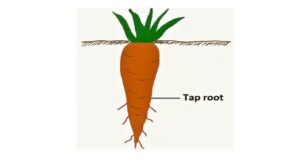Introduction
There are billions of species of plants in this world which can be seen everywhere in the plains, deserts, wetlands, or mountains. Plants evolved about billions of years ago and play many important roles in the ecosystem. All animals including humans are completely dependent on plants for food and shelter. They help in maintaining the balance of oxygen in nature. Plants are of various shapes and sizes, some are thorny, and some plants are so small that they need to be seen with a microscope. The leaves of some plants are very large, and the stems of some plants cannot stand upright on the ground. But each of these plants has more or fewer roots. This root is a major part of the plant by which plants survive by clinging to the soil (1) & (4). This article is about the different types of roots and their major functions and differences.
Root definition
The part of the plant that is under the soil and does not have node, internode, and apical buds are called the roots. In a word, roots are the underground part of a plant. There are different types of roots. Some plants have roots below the ground, while some plants have roots above the ground, i.e. from the stem. Roots absorb minerals, salts, and water from the soil. By this root, the stems of the plants stick firmly to the soil. Usually, the roots of plants originate from the embryonic root. The roots are not leaves, flowers, or fruits. Usually, the roots are downward (3).
Function of roots
The various functions of the roots are
1. The roots collect food sap for the plant from the soil.
2. It also stores food produced in the process of photosynthesis for the future.
3. The most important function of the roots is to absorb water and mineral salts from the soil and reach the leaves through the stems.
4. Root hairs grow on the apex of young roots. This root hair collects food from the soil.
5. The roots keep the plant firmly attached to the soil and prevent soil erosion (1).
Types of roots
The roots are mainly divided into two parts on the basis of place of origin.
1. Taproot

When the dicot seed germinates, the embryonic root produced from that seed forms a long and deep root called the taproot or primary root. Taproots are extremely dense and deep. The embryonic root grows and forms the primary root.
The primary root splits into secondary roots. And the secondary root splits into tertiary roots. Taproots have a primary dense root attached to the stem. And from this main root, several branches are divided and grow. These branches have some thin and white hair-type structure, which is called root hair. Usually, a tap root is somewhat straight and a downward growth occurs (1) & (2).
Example
Carrot, radish, beetroot, parsley, pea, mango, beans, etc. plants have seen tap roots. The orange part of the carrot is tap root (2).
2. Fibrous root or adventitious root

Roots that do not originate from the embryonic root but from any part of the plant such as stem and leaves are called adventitious or fibrous roots.
It has no primary roots that is when the embryonic root is destroyed, this root is formed in a cluster. In fibrous roots, many roots grow from the base of the stem or grow from the leaves.
There are some roots in fibrous roots that are clustered together like rice, coconut, betel nut, etc. And there are some roots that do not grow in clusters, the roots are separated from each other like the silt root of the mangrove palm tree, the prop root of the banyan tree, etc. These types of roots are found in monocot plants.
Fibrous or adventitious roots are thin and cannot extend far below the ground. There are many types of adventitious or fibrous roots based on their function or development (1) & (3).
1. Prop or pillar root
An adventitious root that originates from a stem or branch descends vertically downwards into the soil and takes the shape of a pillar is called a prop or pillar root.
The best example of a prop root is the banyan tree. The roots are formed from the branches of the banyan tree and enter the soil. The roots are nourished by various minerals under the soil and look like the original stems (2) & (3).
2. Stilt root
The roots of most halophytes cannot enter deep into the soft muddy soil. As a result, a bow-shaped root emerges from the stem to hold the plants firmly in the muddy soft soil. These roots are called stilt roots. Sugarcane, Rhizophora, sorghum, etc. are the example of stilt root (3).
3. Climbing root
A climbing root is a root that grows from a weakly stem plant and grabs another plant or support and helps the plant to rise up. It is a kind of adventitious root. The plants that have this type of root are Pothos, piper betel, vanilla, etc. (3).
4. Breathing roots or pneumatophores
The coastal area’s soils are waterlogged and cannot be aerated. As a result, ventilation cannot occur at the roots. That is why, a type of root of a halophyte plant pierces the soil, rises in the open air in the opposite direction of gravity, and participates in gaseous exchange. These roots are called breathing roots or pneumatophores (3).
5. Aerial root
Aerial roots are found in many orchids that grow on tree branches. These roots do not absorb any food from the host plant. Aerial roots are aerated and hang freely in the air. Every root has a spongy tissue, called a velamen. This hanging root absorbs moisture from the atmosphere by velamen (3).
6. Leaf root
Leaf roots are found in bryophyllum plants. These roots grow from the leaves of the plants. If the leaves of a bryophyllum tree have been lying on the wet soil for a long time, the root that is formed from there is the leaf root (3).
7. Floating root
A bunch of roots is emitted from the stems of aquatic animals. These roots help the aquatic plants stay afloat. This root is called a floating root. Floating roots can be seen in waterlilys, duckweeds, jussiaea, etc. (2) & (3).
8. Sucking root or haustoria
Sucking roots are found in parasitic plants. The best example of sucking root is the dodders plant. This root has no connection with the soil. Parasitic plants do not contain chlorophyll, so the hosts insert a special type of root into the plant’s body for food. These roots are called sucking roots (3).
Difference between taproot and fibrous root
Some differences between taproot and fibrous root are discussed below (3) & (4).
Content |
Taproot |
Fibrous root |
| 1. Definition | Taproot is a primary root. | The fibrous root is the cluster root. |
| 2. Types of roots | They are extremely thick. | Fibrous roots are thin. |
| 3. Extension of roots | Taproots are very dense. That is these roots can extend vertically far below the ground. | These roots cannot extend far into the depths of the soil. |
| 4. Develop | The embryonic root grows and forms the taproot. | This type of root develops from the stems or leaves of the plant. |
| 5. Occur | Taproots occur in dicot plants. | These types of roots occur in monocot plants. |
| 6. Growth nature | The growth of this root is always at the bottom of the soil. | Fibrous roots grow both below and above the ground. |
| 7. Branching | There are branches of taproots or primary roots. The primary root splits into secondary roots. And the secondary root splits into tertiary roots. | There are no branches of the fibrous like the taproot. They grow in clusters from the base of a plant. |
| 8. Water absorption capacity | The water absorption capacity of the taproot is higher than that of the fibrous root. These roots can absorb water from deeper layers of soil. | Fibrous roots cannot absorb water from deeper layers of soil because fibrous or adventitious roots are thin and cannot extend far below the ground. |
| 9. Food Storage | Taproot can store food for the future. | The fibrous root cannot store anything. |
| 10. Soil particles holding ability | The taproot cannot hold many soil particles together. | The fibrous root is clustered so this root can hold a large number of soil particles and helps prevent soil erosion. |
| 11. lifespan | Plants that have taproots or primary roots have a long life. | The lifespan of plants with fibrous roots is very short. |
| 12. Create from embryonic root | The taproot is formed from the embryonic root and enters the soil. | When the embryonic root of a plant is destroyed, the fibrous root is created in clusters around the embryonic root. |
| 13. Consist of | Taproot consists of a primary root. | The fibrous root consists of more than one root. |
There are some similarities between taproot and fibrous root
- Both taproot and fibrous roots absorb water and minerals from the soil.
- These roots help to hold the stems of the plants firmly in the ground.
- Taproots and fibrous roots prevent soil erosion.
- Both roots grow towards the soil due to gravity (except breathing roots or pneumatophores) (2) & (4).
Characteristics of the roots of different plants
| Plants type | Characteristics of roots |
| 1. Hydrophytes |
|
| 2. Mesophytes |
|
| 3. Xerophytes |
|
| 4. Halophytes |
|
Q&A
1. What are the two main types of roots?
The two main types of roots in plants are taproot and fibrous roots. The tap roots system is mainly developed in dicots and later is found in the monocots.
2. What are the two main types of roots?
Taproot and Fibrous root are the two main types of roots.
